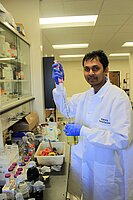Biopolymers for Phosphate Removal from Eutrophic Lakes

Mohammad Enayet Hossain is a Doctor of Philosophy (PhD) student in Environmental and Conservation Sciences program at North Dakota State University (NDSU). His parent department is Civil and Environmental Engineering. He received his MS in Soil Science and BS in Soil, Water and Environment from the University of Dhaka, Bangladesh. Before joining NDSU, Enayet worked as a faculty member in the Department of Soil, Water and Environment at the University of Dhaka and Chittagong University in Bangladesh. His NDWRRI-supported research is focused on the removal of phosphate from eutrophic lakes as well as from wastewater and animal feedlot effluent using biopolymers and subsequent use of biopolymer-sorbed phosphate in agriculture.
Email: mohammad.e.hossain@ndsu.edu
Phone: 701-866-9317
Fellow: Mohammad Enayet Hossain
Advisor: Achintya Bezbaruah, Ph.D, Associate Professor, Department of Civil and Environmental Engineering, North Dakota State University
Degree Progress: Ph.D in Environmental Sciences
Biopolymers for Phosphate Removal from Eutrophic Lakes
Phosphorus (P) is vitally important for the growth of plants and microorganisms in the ecosystems. However, excess phosphorus present in aquatic bodies leads to the overgrowth of algae and plant species, and finally leads to eutrophication of the waterbodies. Even though eutrophication is a natural process, it is sped up through anthropogenic activities. Accelerated eutrophication not only impacts the aquatic life but indirectly hampers the economic progress of communities that rely on the waterbodies for aquatic food and other resources. Phosphate as low as 0.02 mg/L is known to cause profuse algal growth in waters. Eutrophication of lakes is a major problem in North Dakota as well. According to the North Dakota Department of Health (NDDH), ~52% (87 lakes) are eutrophic and ~17% (29 lakes) are hypereutrophic among the lakes surveyed. Moreover, ~56% of the lakes are considered threatened indicating that if the water contamination goes on at the current rate, it is unlikely that these waterbodies will continue to support aquatic life and the water will be fit for human uses. The amount of P-compounds in waters should be reduced to prevent eutrophication of lakes and other surface waters. Therefore, it is imperative to devise effective methods to remove excessive phosphate from water and wastewater. Presently, there is a significant gap in technology to remove P from waters when present in low concentrations (in the microgram levels). There is another often overlooked aspect to the P issue. Phosphorus for fertilizer production is mined chiefly from select phosphate mines from Morocco, Western Saharan region, Peru, and China. The United States’ phosphate imports come from Morocco and Peru in addition to using its own mines. Phosphorus is a nonrenewable resource and a recent assessment indicated that natural phosphate deposits will last for approximately 60-240 years. The present NDWRRI research involves the use of novel biopolymer beads for phosphate removal from eutrophic water and wastewater and reusing the spent beads (with sorbed phosphate) for agricultural purposes as a source of phosphate for plants. The research, if successful, will provide a robust and sustainable technology (or technologies) to remove and recover aqueous phosphate.
Project Objectives:
The main objective of this research is to determine if biopolymer beads can be used to remove aqueous phosphate and then use the phosphate as a plant fertilizer. The specific objectives of this work are:
- To investigate the phosphate sorption characteristics of biopolymer-based beads
- To identify the P sorption and desorption mechanisms of the beads
- To determine the feasibility of using the beads in eutrophic lakes reclamation
- To use the beads for phosphate removal from wastewater and animal feedlot effluent
- To measure the bioavailability of bead-sorbed P for possible use in agriculture
Progress:
The biopolymer-based beads have been synthesized and characterized. Batch studies were carried out with different concentrations of phosphate and satisfactory removal was achieved with the biopolymer beads. The biopolymer beads worked well for both high (up to 30 mg/L) and low (~100 µg/L) concentrations of phosphate. Study carried out to see the feasibility of using the beads in real-life (lake) conditions also gave satisfactory results.
Significance:
This research work will enable us to alleviate the problem of eutrophication of lakes. In addition, this research will contribute towards generating a new source for phosphorus for agricultural uses and, thus, contribute towards better crop production in North Dakota and improve global food security.
Peer-Reviewed Journal Papers:
Hossain, M.E., Ritt, C., Almeelbi, T., Bezbaruah, A.N. Biopolymer Beads for Aqueous Phosphate Removal: Possible Application in Eutrophic Lakes (to be submitted to Environmental Science & Technology)
Hossain, M.E., Almeelbi, T., Ritt, C., Bezbaruah, A. Mechanisms of Phosphate Removal by Metal Cross-linked Biopolymers, Proc. World Environmental and Water Resources Congress 2014, Environment and Water Resources Institute of American Society for Civil Engineers, 2014.
Conference/Seminar Presentations:
Hossain, M.E., Ritt, C., Bezbaruah, A. Development of Biopolymer-based Slow-release Phosphate and Iron fertilizers, World Environmental & Water Resources Congress, Austin, TX, May 2015. (Oral presentation)
Hossain, M.E., Ritt, C., Bezbaruah, A. Iron Cross-linked Biopolymer for Aqueous Phosphate Removal. Poster Competition held in the 10th Anniversary of Environmental and Conservation Sciences Program at NDSU, Fargo, ND, October 28, 2014. (Poster presentation). (This poster won the second prize)
Hossain, M.E., Ritt, C., Bezbaruah, A. Iron Cross-linked Biopolymer for Aqueous Phosphate Removal. Young Professionals Poster Competition at the North Dakota Water and Pollution Control Conference (NDWPCC). American Water Works Association North Dakota Section, North Dakota Water Environment Association, Fargo, ND, October 14, 2014. (Poster presentation). (This poster won the overall best poster award and as well as the best poster award in wastewater category)
Hossain, M.E., Ritt, C., Bezbaruah, A. Development of Biopolymer-based Slow-release Phosphate and Iron Fertilizers. International Prairie Student Conference 2014, Student Chapter of American Water Works Association/Water Environment Federation (NDSU AWWA/WEF), Fargo, ND, August 7, 2014. (Oral presentation)
Hossain, M.E., Almeelbi, T., Kalita. H., Ritt, C., Bezbaruah, A. Phosphate Removal by Metal Cross-Linked Biopolymers, World Environmental and Water Resources Congress 2014: Water without Borders Conference, Portland, OR, June 4, 2014. (Oral presentation)
Hossain, M.E., Ritt, C., Bezbaruah, A.N. Iron Cross-linked Biopolymer for Aqueous Phosphate Removal, Surface Water Treatment Workshop, Fargo, ND, April 29, 2014. (Poster presentation)
Hossain, M.E., Ritt, C., Bezbaruah, A.N. Iron Cross-linked Biopolymer for Aqueous Phosphate Removal, North Dakota Water Quality Monitoring Conference, Bismarck, ND, March 4-6, 2014. (Poster presentation)
Patent:
Bezbaruah, A.N., Almeelbi, T., Quamme, M., Hossain, M.E. Aqueous Phosphate Removal using Iron Cross-lined Alginate, Patent Filed, PCT/US2014/028524, 2014.

Achintya Bezbaruah
Civil & Environmental Eng.
Office: Civil/Ind Eng 201G
Telephone: 701-231-7461
Email: a.bezbaruah@ndsu.edu


